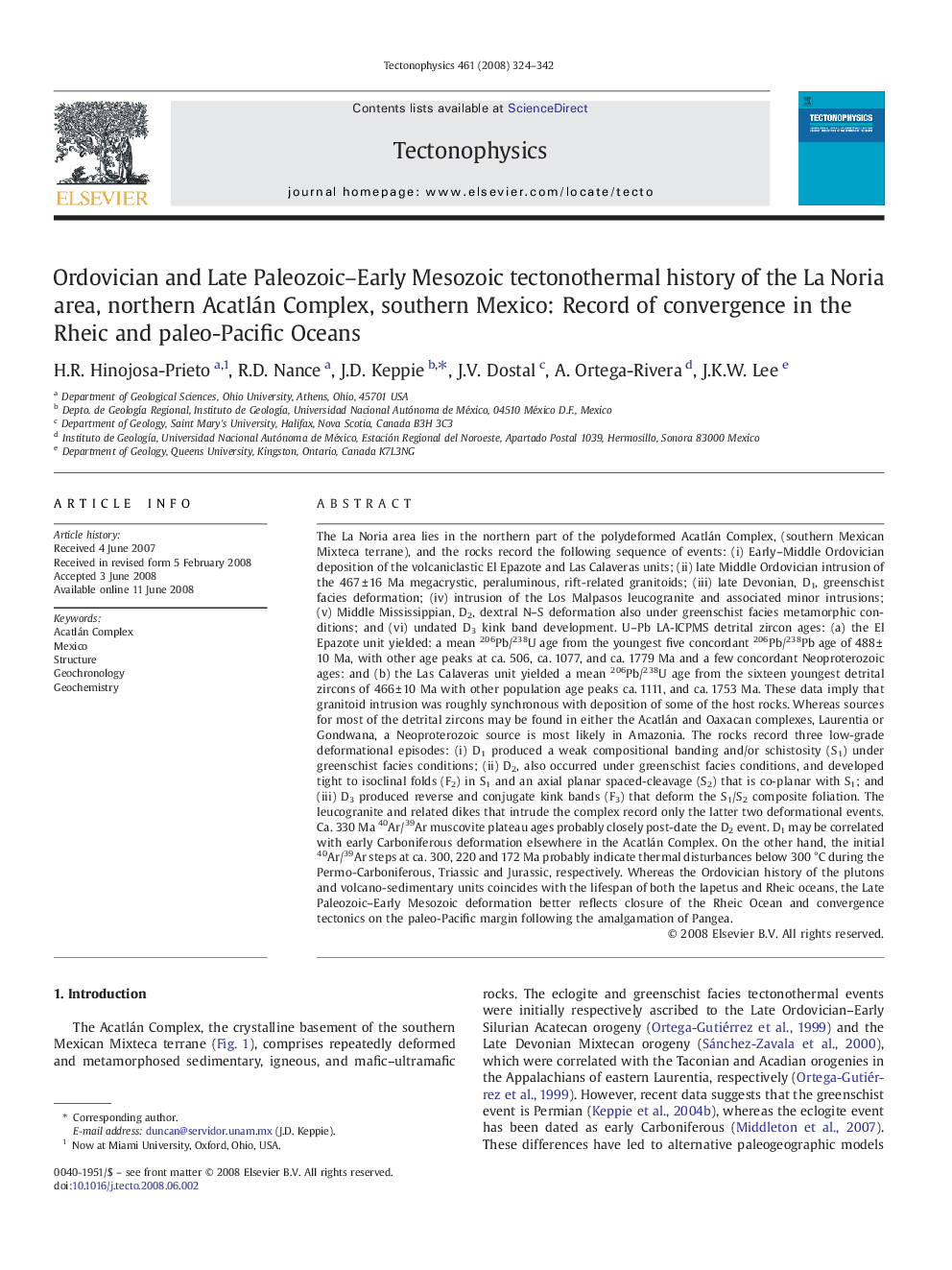| کد مقاله | کد نشریه | سال انتشار | مقاله انگلیسی | نسخه تمام متن |
|---|---|---|---|---|
| 4694192 | 1636904 | 2008 | 19 صفحه PDF | دانلود رایگان |
عنوان انگلیسی مقاله ISI
Ordovician and Late Paleozoic-Early Mesozoic tectonothermal history of the La Noria area, northern Acatlán Complex, southern Mexico: Record of convergence in the Rheic and paleo-Pacific Oceans
دانلود مقاله + سفارش ترجمه
دانلود مقاله ISI انگلیسی
رایگان برای ایرانیان
کلمات کلیدی
موضوعات مرتبط
مهندسی و علوم پایه
علوم زمین و سیارات
فرآیندهای سطح زمین
پیش نمایش صفحه اول مقاله

چکیده انگلیسی
The La Noria area lies in the northern part of the polydeformed Acatlán Complex, (southern Mexican Mixteca terrane), and the rocks record the following sequence of events: (i) Early-Middle Ordovician deposition of the volcaniclastic El Epazote and Las Calaveras units; (ii) late Middle Ordovician intrusion of the 467 ± 16 Ma megacrystic, peraluminous, rift-related granitoids; (iii) late Devonian, D1, greenschist facies deformation; (iv) intrusion of the Los Malpasos leucogranite and associated minor intrusions; (v) Middle Mississippian, D2, dextral N-S deformation also under greenschist facies metamorphic conditions; and (vi) undated D3 kink band development. U-Pb LA-ICPMS detrital zircon ages: (a) the El Epazote unit yielded: a mean 206Pb/238U age from the youngest five concordant 206Pb/238Pb age of 488 ± 10 Ma, with other age peaks at ca. 506, ca. 1077, and ca. 1779 Ma and a few concordant Neoproterozoic ages: and (b) the Las Calaveras unit yielded a mean 206Pb/238U age from the sixteen youngest detrital zircons of 466 ± 10 Ma with other population age peaks ca. 1111, and ca. 1753 Ma. These data imply that granitoid intrusion was roughly synchronous with deposition of some of the host rocks. Whereas sources for most of the detrital zircons may be found in either the Acatlán and Oaxacan complexes, Laurentia or Gondwana, a Neoproterozoic source is most likely in Amazonia. The rocks record three low-grade deformational episodes: (i) D1 produced a weak compositional banding and/or schistosity (S1) under greenschist facies conditions; (ii) D2, also occurred under greenschist facies conditions, and developed tight to isoclinal folds (F2) in S1 and an axial planar spaced-cleavage (S2) that is co-planar with S1; and (iii) D3 produced reverse and conjugate kink bands (F3) that deform the S1/S2 composite foliation. The leucogranite and related dikes that intrude the complex record only the latter two deformational events. Ca. 330 Ma 40Ar/39Ar muscovite plateau ages probably closely post-date the D2 event. D1 may be correlated with early Carboniferous deformation elsewhere in the Acatlán Complex. On the other hand, the initial 40Ar/39Ar steps at ca. 300, 220 and 172 Ma probably indicate thermal disturbances below 300 °C during the Permo-Carboniferous, Triassic and Jurassic, respectively. Whereas the Ordovician history of the plutons and volcano-sedimentary units coincides with the lifespan of both the Iapetus and Rheic oceans, the Late Paleozoic-Early Mesozoic deformation better reflects closure of the Rheic Ocean and convergence tectonics on the paleo-Pacific margin following the amalgamation of Pangea.
ناشر
Database: Elsevier - ScienceDirect (ساینس دایرکت)
Journal: Tectonophysics - Volume 461, Issues 1â4, 1 December 2008, Pages 324-342
Journal: Tectonophysics - Volume 461, Issues 1â4, 1 December 2008, Pages 324-342
نویسندگان
H.R. Hinojosa-Prieto, R.D. Nance, J.D. Keppie, J.V. Dostal, A. Ortega-Rivera, J.K.W. Lee,